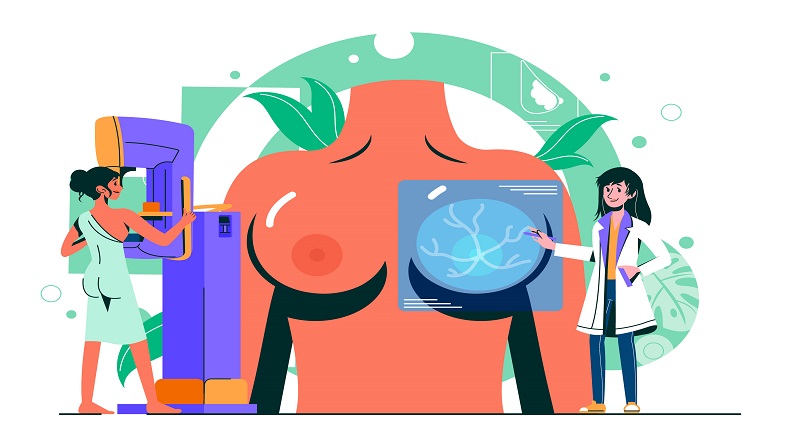The importance of regular screening and early detection is highlighted by the fact that breast cancer is a common yet potentially curable disease. This blog explores the value of breast cancer screening, emphasizing clinical breast exams alongside mammography and breast self-examination (BSE). We may empower ourselves and others to take proactive actions towards early diagnosis and better outcomes by becoming familiar with these techniques and recognizing the indicators of breast cancer.
Importance of Breast Cancer Screening:
Breast cancer screening is essential for finding breast tissue anomalies before they progress to more serious stages. Early detection of breast cancer greatly increases the likelihood of effective treatment and enhanced quality of life. For women who may have a higher risk of developing breast cancer or who have genetic abnormalities, routine screening is especially important since they can benefit tremendously from proactive monitoring and management. We prioritise our long-term wellbeing by giving screening priority.
Mammograms and Their Significance:
The cornerstone of breast cancer screening is the mammogram, an X-ray scan of the breast. Tumours that are too tiny to be felt during a physical examination can be found with these screens.Mammograms are essential for early breast cancer detection, allowing for prompt medical measures. Although recommendations may change, it is typically advised that women between the ages of 40 and 74 get routine mammograms every one to two years. To maximise their chances of early diagnosis, women with specific risk factors may need to start screenings sooner or undergo them more frequently. Mammograms are part of our regular medical checkups, which guarantees proactive monitoring.
Breast Self-Examination (BSE):
Women are empowered by breast self-examination (BSE), which helps them get accustomed to how their breasts typically feel and look. Women can more easily spot any changes or anomalies by doing BSE routinely, often once a month. Although BSE doesn’t replace clinical examinations or mammograms, it adds another layer of awareness and can help women spot possible problems before they become serious. Use these methods to efficiently do a BSE. By setting out a few minutes each month for BSE, we proactively protect the health of our breasts.
- Stand in front of a mirror: With your arms at your sides, stand in front of a mirror and look at your breasts. Keep an eye out for any apparent changes in size, shape, or contour.
- Raise your arms: Raise your arms above your head and take a fresh look at your breasts to see if anything has changed.
- Lie down and palpate: Use your right hand to feel your left breast while you are lying down, and vice versa. With your initial few fingers, apply a firm, circular motion to the breast tissue to carefully examine it.
- Check the armpit area: To check for lumps, bumps or texture changes, gently touch the entire breast, including the area under the arm.
- Repeat regularly: To track any changes over time, consistently carry out self-examinations once a month.
Clinical Breast Exams:
Healthcare experts do clinical breast exams, which comprise a comprehensive inspection of the breasts and surrounding areas for any abnormalities. These examinations, which are typically included in routine check-ups, offer a qualified evaluation of breast health. They offer a professional assessment of breast tissue and the early identification of potential problems, acting as a crucial supplement to self-examinations and mammograms. We ensure a thorough approach to breast health by combining clinical breast exams into our daily healthcare routine.
Signs of Breast Cancer:
Understanding breast cancer symptoms is essential for early detection and quick medical intervention. Typical indications include:
- Lump Formation: The finding of a new tumour or lump in the breast or underarm region is referred to as lump formation.
- Change in Breast Size or Shape: Any inexplicable change in the breast’s size, shape, or contour.
- Skin Changes: Significant dimpling, puckering, or redness of the skin on the breast’s surface.
- Nipple Changes: The nipple’s modifications, such as inversion, discharge, or scaliness.
- Pain or Discomfort: Constant soreness or discomfort under the breasts or in the armpits that doesn’t go away.
- Texture Changes: The breast’s texture changed and resembled an orange peel.
- Unexplained Swelling: Unaccounted For breast swelling, even in the absence of pain or discomfort.
- Unexplained Weight Loss: Unaccounted-for weight loss is sudden loss of weight unrelated to dietary or exercise modifications.
- Fatigue: Constant fatigue that doesn’t go better after a nap. Knowing these symptoms enables us to seek prompt medical attention.
In conclusion, early detection and screening for breast cancer are essential to women’s health. Breast self-examinations (BSE), clinical breast exams, and mammograms are effective tools that empower women to actively participate in their health. Regular screenings and self-awareness enable the early detection of potential issues, which improves results and the effectiveness of therapy.
You should prioritise your health by seeking out individualised advice from medical professionals. Oncologists like Dr. Subraharsh Singh, the best oncologist in Lucknow, can provide thorough care and unique insight into breast cancer screening. We all work towards healthier lives and a better future for women by raising awareness of breast cancer screening techniques, emphasising the value of early diagnosis, and developing a culture of proactive health management.



